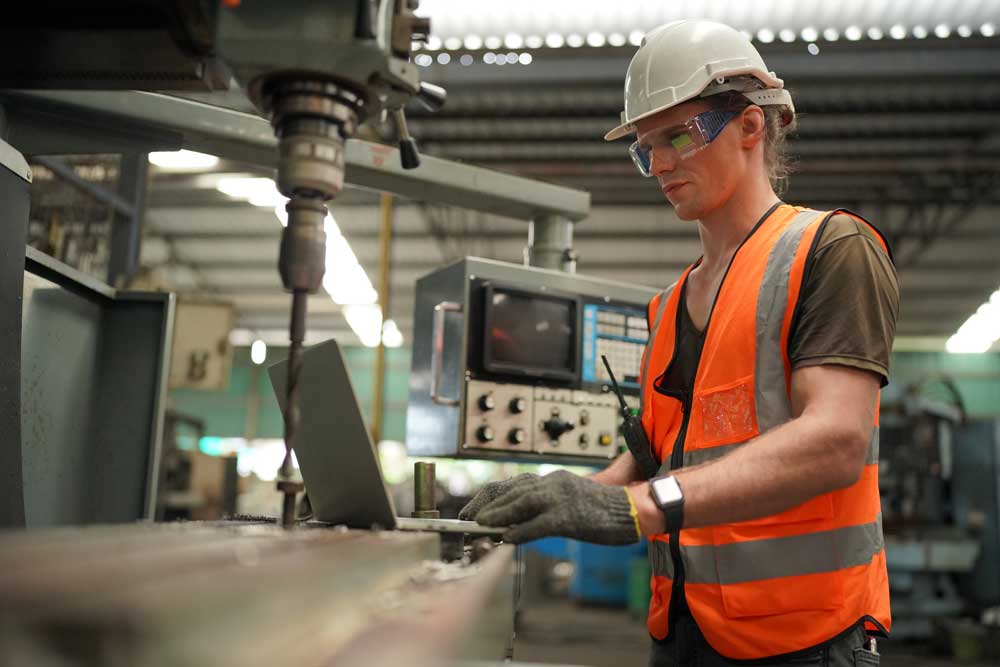Lean manufacturing has established itself as one of the hottest talking points in modern business. If your company has yet to adopt this way of working, the beginning of a new year signals the opportune moment to transform its production process forever.
This guide will help you upgrade your manufacturing processes through lean thinking. It aims to answer all of your key questions on lean production, including but not limited to;
- What is lean manufacturing?
- Why is lean manufacturing important?
- What are the five key principles of lean manufacturing?
- How can your business introduce lean manufacturing?
Whether you already use OEE software for lean production or you’re a complete newbie to this arena doesn’t matter. The road to continuous improvement starts now.
What is lean manufacturing?
Experts at Techopedia define lean manufacturing as “a systematic manufacturing method used for eliminating waste within the manufacturing system”, explaining that “it takes into account the waste generated from uneven workloads and overburden and then reduces them in order to increase value and reduce costs”.
In other words, it is a manufacturing philosophy that minimizes waste – in terms of time, money, and materials – to build a better business model and provide maximized customer value. It additionally covers the concept of removing elements that do not add to this sense of worth.
While it was formerly a concept exclusive to major organizations, it has become increasingly accessible for SMEs in recent years with an estimated 70% now using lean production in some shape or form.

How does the Toyota production system work?
It is commonly accepted that the Toyota production system was the first example of lean processes and has since become a focal point of studies into the concept and its mechanisms.
Toyota’s methodology for vehicle production is built upon the foundation of making only “what is needed, when it is needed, and in the amount needed”. While it is a strategy that has been fine-tuned over several decades, it still aims to eliminate production waste, eradicate production inconsistencies, and bypass unreasonable requirements. To do this it splits the types of waste into three main areas;
- Waste caused by changing demands due to customer demands or outside factors. (Mura)
- Resource waste, including time, due to overburdening workers or machinery and tools. (Muri)
- Waste caused by unnecessary tasks that do not add value or support tasks that do. (Muda)
The Toyota production system TPS is one that simultaneously relies on clear communication between teams and organized assembly lines to ensure that client orders can be satisfied in the quickest and most cost-effective fashion.
It additionally identifies seven key examples of waste that must be eradicated. They are; unnecessary transportation, excess inventory, unnecessary movement of assets or people, waiting times, overproduction, over processing, and defects. Modern lean manufacturing companies also avoid unused talent.
While Toyota’s methodology is focused on the complete elimination of all waste within the automobile arena, the fundamentals carry universal appeal and can become the catalyst for success in virtually all manufacturing verticals.
The benefits of eliminating waste through lean manufacturing
Toyota’s continuous improvement proves that lean manufacturing works, but any business looking to make it a key feature of its company culture will need to verify its value.
Firstly, it should be noted that the global market for digital transformations within manufacturing landscapes was valued at $220bn in 2018 and is forecast to hit $642bn by 2025. The fact that other companies are actively moving towards lean manufacturing methods cannot be ignored if you want to survive in the current business climate.
Crucially, though, eliminating waste via a lean production system will deliver a host of tangible and intangible rewards for the company. Some of the most telling results include, but are not limited to;
- You will establish a company culture where all employees view individual and company-wide processes from the customer’s perspective. Crucially, they will learn to ask “does this process give the client added value that they are willing to pay for?”. In turn, this will help them quickly identify the processes that should be dropped in a bid to eliminate waste.
- A focus on lean manufacturing actively encourages you to monitor and manage machinery, equipment, and other tools. When you spot faults or reduced performance levels, you will be better positioned to prevent downtime and slow productivity. Given the cost of unplanned downtime, it can help keep your business on the right path. It’ll also protect your reputation.
- When you eliminate waste, it will translate to significant savings of time and money. This is because implementing lean manufacturing techniques will improve your workflows while simultaneously reducing unnecessary aspects that could be adding to your overheads. It is a move that also promotes shorter lead times, which unlocks greater productivity on a daily basis.
- The fact that lean management ensures that all decisions affecting the supply chain are made in relation to client viewpoints ultimately leads to greater customer satisfaction levels. Happy consumers will bring greater conversion rates and brand loyalty while 86% will pay more for a better customer experience. As such, sales revenue should climb.
- By removing waste, your lean manufacturing plants will naturally utilize fewer resources and consume less energy. When combined with the removal of excess inventory, a standard lean production model can be considered a major step towards becoming an eco-friendly business. This can subsequently become a key part of your brand image.
Lean manufacturing will help you build a better business by improving your company culture, customer satisfaction, productivity, and environmental impact while still boosting your bottom line.
What are the key principles of lean production?
Lean enterprise habits within the manufacturing industry must focus on the five key principles of this business model, which were set by Toyota but can deliver stunning results in all sectors where manufacturing processes occur.
Likewise, the lean methodology can be used regardless of whether you are looking to ultra advanced concepts like automated factories or simply focusing on the goal of reducing waste caused by humans or machinery. The five principles that every lean company should focus on are;
- Value – this means viewing the company from the customer’s perspective to gain a better understanding of how much they may be happy to pay for your products. By determining value from the client’s perspective, businesses should find it easier to eliminate unnecessary features so that the best product and maximum profit margins are achieved.
- Value stream mapping – by analyzing all resources used throughout a product’s lifecycle, starting from raw materials, it is possible to pinpoint waste and make improvements. Chain alignment is a popular technique for value stream mapping, not least because it means that the resources and materials are accounted for at every stage of manufacturing.
- Create flow – building a better workflow ensures that production remains constant without delays or unnecessary overheads. The aim of this principle is to accelerate the company’s lead times, which ultimately improves customer satisfaction levels and will make 93% of clients more likely to use the company again. Removing production barriers supports workers too.
- Pull system creation – customer demand should lead your manufacturing processes, not least as you look to avoid excessive inventories and stock. A manufacturing resource planning (MRP) system should utilize sales forecasts while it also relies on clear communication and ensuring that you only move on to the next task once previous steps have been completed.
- Kaizen – a term coined by the Toyota model, Kaizen essentially means that you will continue to pursue perfection. Lean practitioners understand that it isn’t a task that can be checked off. It is a methodology that creates a culture of always striving for better. Etymologically speaking, “kai” translates to “change” and “zen” translates to “change”.
The underlying principles of a successful lean process should cover the entire supply chain with a commitment to reducing all types of waste. In today’s business landscapes, the physical manufacturing processes must be supported by several outside elements and additional teams. to achieve a continuous process improvement.

Is lean manufacturing the same as Six Sigma?
When considering the aims of lean manufacturing, it is easy to see why many people think that it is essentially the same as Six Sigma. While they do both set out to eliminate waste from the process, the lean techniques do have some key differences. They can actually work conjunctively through a process known as Lean Six Sigma.
Lean manufacturing relates solely to manufacturing cycles, minimizing waste in all relevant aspects of the process to gain maximum returns for productivity and profitability. Six Sigma focuses on reducing waste through the modification of management processes to increase the production value. While Six Sigma can be introduced in other business sectors, it does tend to overlook any human elements that are not directly linked to output.
A lean manufacturing cycle and lean management process can be improved with the outside help of Six Sigma. However, the latter rarely delivers a process improvement when used to replace rather than complement the former. In short, most manufacturing firms will benefit primarily from implementing lean concepts first.
Does your business need lean production?
The fact that you are looking for ways to improve your company’s manufacturing processes instantly suggests that it could benefit from lean manufacturing processes. After all, its goal is to continually improve the company’s output by eliminating both tangible and intangible waste.
Lean manufacturing can potentially impact all 15 million plus Americans working in the manufacturing industry, from those working at small local startups to those working for global organizations. However, its implementation is particularly noteworthy for production supervisors, operations managers, plant controllers, maintenance engineers, financial controllers, plant managers, and business owners.
In truth, most manufacturing businesses can benefit from taking a proactive approach to lean processes. Still, if the company notices any of the following issues, it is imperative that those upgrades come sooner rather than later;
- Deadlines are regularly missed,
- Unscheduled downtime and maintenance are a regular occurrences,
- Defects and returns are commonplace,
- Productivity output is lower than you’d expect from your team,
- Employees are unhappy or unengaged,
- You are left with high levels of stock or inventory,
- Customer satisfaction levels are low,
- Other changes you’ve implemented have made very little difference.
When the above issues are relevant to your business, you must introduce OEE reporting and other lean manufacturing tools that can eradicate waste from your value chain.
How to build a lean production system
Understanding the benefits of lean manufacturing, along with its mission statement is one thing. However, knowing how to implement a lean principle with a meaningful and lasting difference in mind is another altogether. It may seem like a daunting prospect, but the truth is that modernizing your business in this way is probably far more accessible than you imagine.
Thousands of small businesses like yours are using lean business models to achieve a variety of benefits. The following lean manufacturing techniques and tools may be used to support the manufacturing process cycle;
- Just-in-time (JIT) – also known as just-in-sequence, it is a technique that means that you provide what the client wants just as they want it. Its purpose is to reduce inventory waste and ensure that you focus simply on satisfying customer demands.
- Gemba – a Gemba walk is when managers or production supervisors visit a site to analyze the physical working environments as well as the processes that take place inside them. It is a chance to spot various sources of waste.
- Jidoka – it is a methodology that focuses on the ability to detect an abnormality and quickly stop work in this arena until the issue is corrected and the root cause can be found in order to prevent repeat episodes.
- Kanban – this is a strategic process that breaks tasks down into three aspects – to do, doing, and done. This means that projects keep moving towards their logical conclusions to promote inventory reduction and facilitate collaboration without delay.
- Bottlenecks – identifying bottlenecks focuses on identifying and eradicating inefficiencies that have consequently caused slow productivity speeds. It will indirectly lead to benefits throughout other stages of the manufacturing cycle.
- Poka-yoka – this is a strategic endeavor that aims to remove human errors. It may involve using alert systems if a step is missed or completed incorrectly by any member of the workforce.
- Six losses – focusing on breakdowns, setups, small stops, reduced speed, startup rejects, and production rejects is another effective technique that enables most manufacturing plants to prioritize the biggest dangers to productivity.
For optimized results, these techniques should be integrated within the context of the principles mentioned above. Meanwhile, it is equally important to focus on monitoring the results. Aside from confirming that progress has been made, it will form a key step as you look to achieve continuous improvement.
Perhaps the best tip for introducing lean workflows is that you must get your whole workforce involved. If this means making an investment in staff training or incentivizing them through the transitional phase, it will be worth it in the long run.

How the OEE method fits in with lean manufacturing principles
Overall Equipment Efficiency doesn’t necessarily deliver a lean manufacturing process on its own. However, it is an effective framework that will actively support the lean principles of the production process as it aims to keep all machinery and equipment operating at optimal efficiency.
Utilizing the OEE method means that teams throughout the manufacturing supply chain will track down time, slow cycles and rejects. OEE is also shown to overcome the six big losses mentioned above. While it focuses on the tools and machinery rather than the workers, it is a measurement framework that has become increasingly important in an era where manufacturing plants are moving closer and closer to fully automated business models.
Furthermore, most businesses find that OEE identifies a level of waste that catches them by surprise. Working to improve those target areas will subsequently bring a dramatic upturn in productivity across the value chain while organically developing lean thinking perspectives that covers all of the five lean principles.
Machine monitoring and machine learning software can take the benefits of OEE to the next level by collecting real-time data and providing visualizations of the relevant information. In turn, teams can make calculated decisions or even automate issues like scheduling downtime and equipment maintenance. Better still, cloud-based management facilitates lean manufacturing across the entire enterprise and its various locations.
Conclusion
If manufacturing processes are a feature of your business model, lean production should be a priority for 2023 and beyond. It delivers a wealth of benefits that range from building a better company culture to promoting increased customer satisfaction. When combined with the fact that advanced tech like OEE software facilitates a smoother transition than ever before, you cannot afford to resist the future of manufacturing for a minute longer.
To learn more about lean manufacturing and how it can support your business, contact the OEE Systems team today.